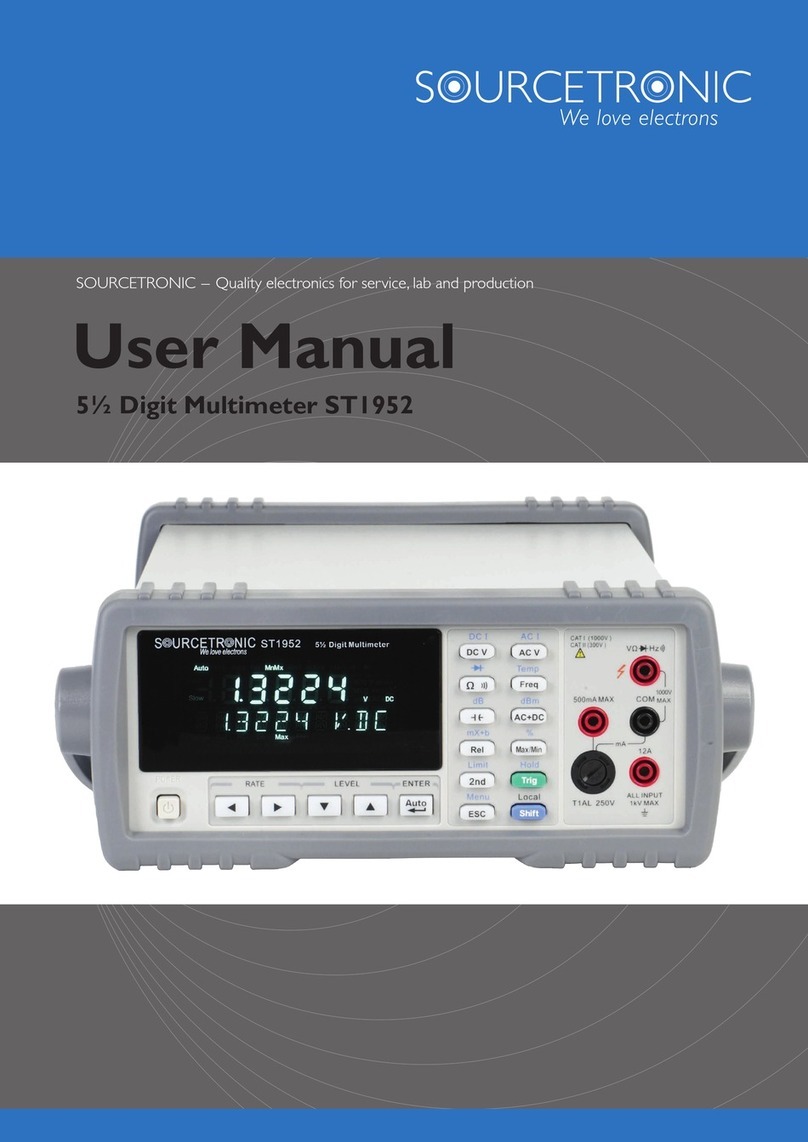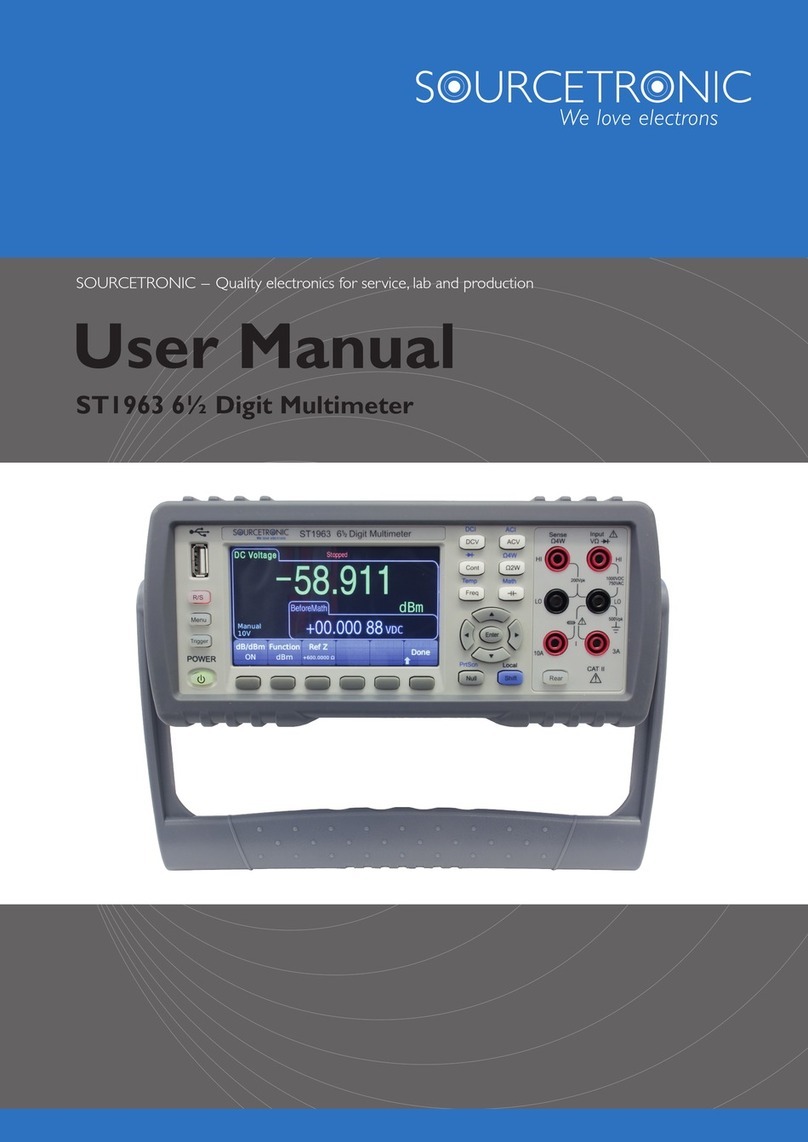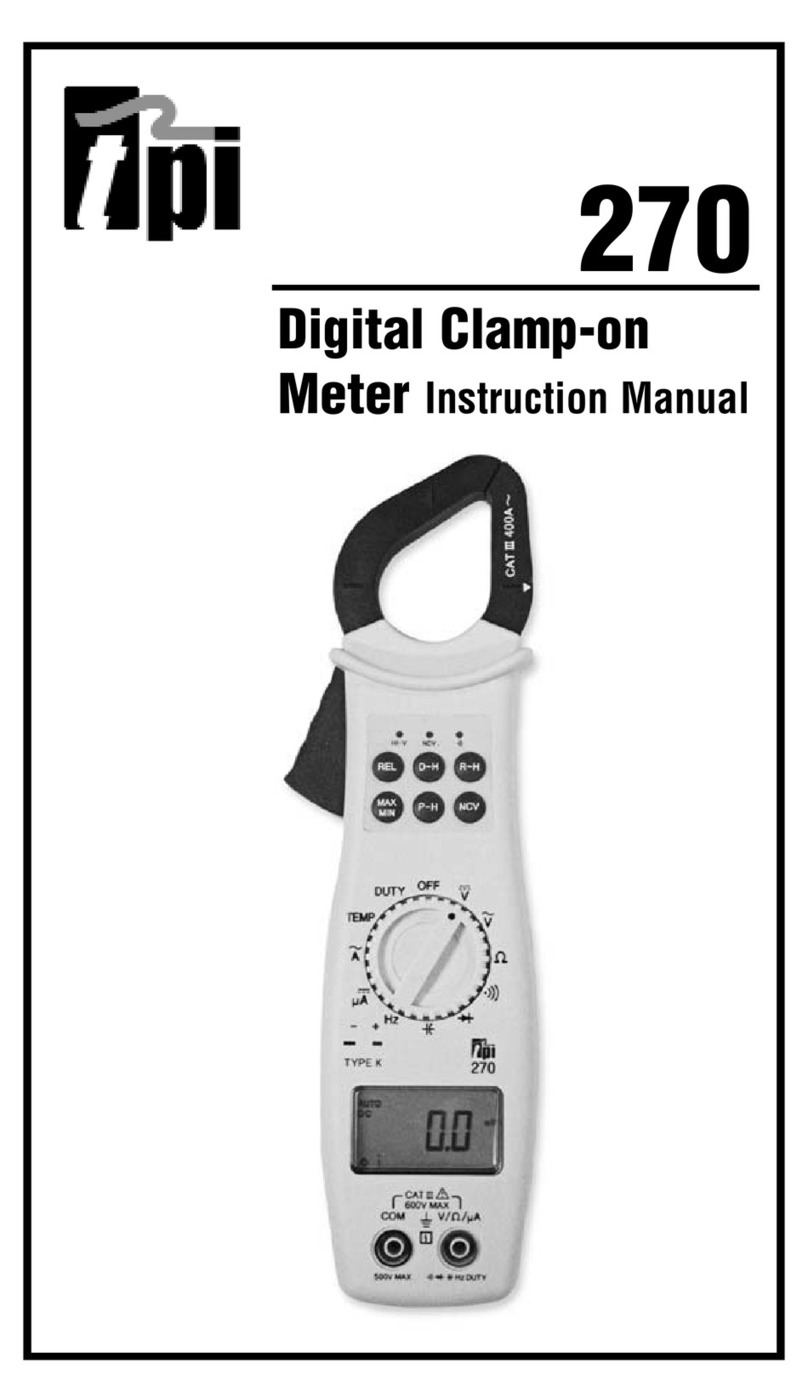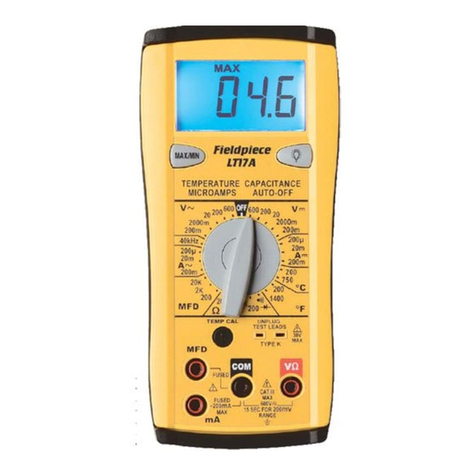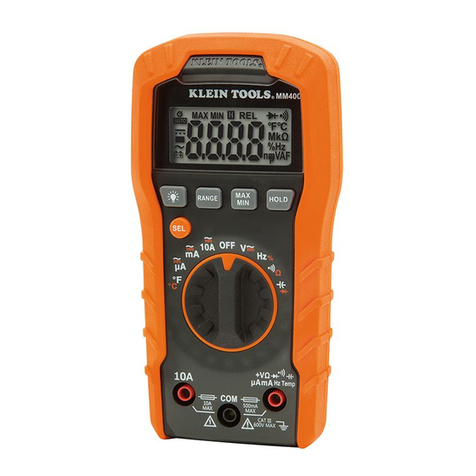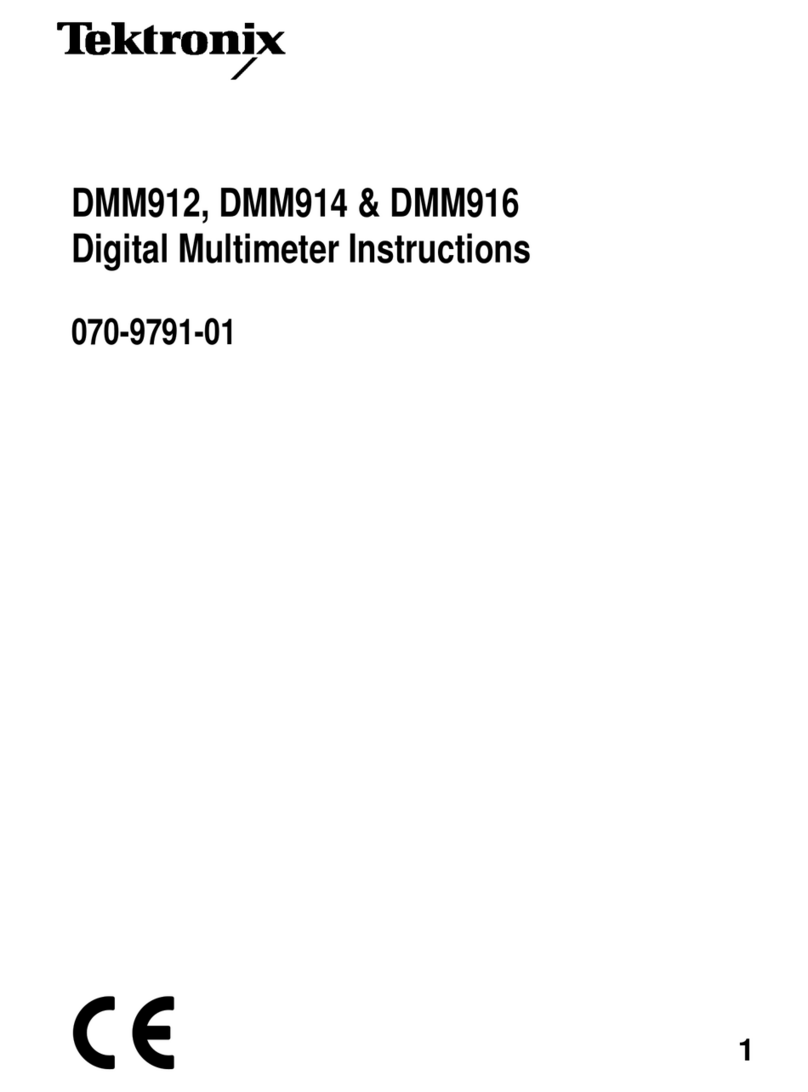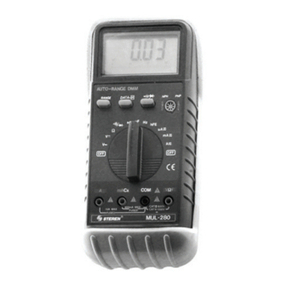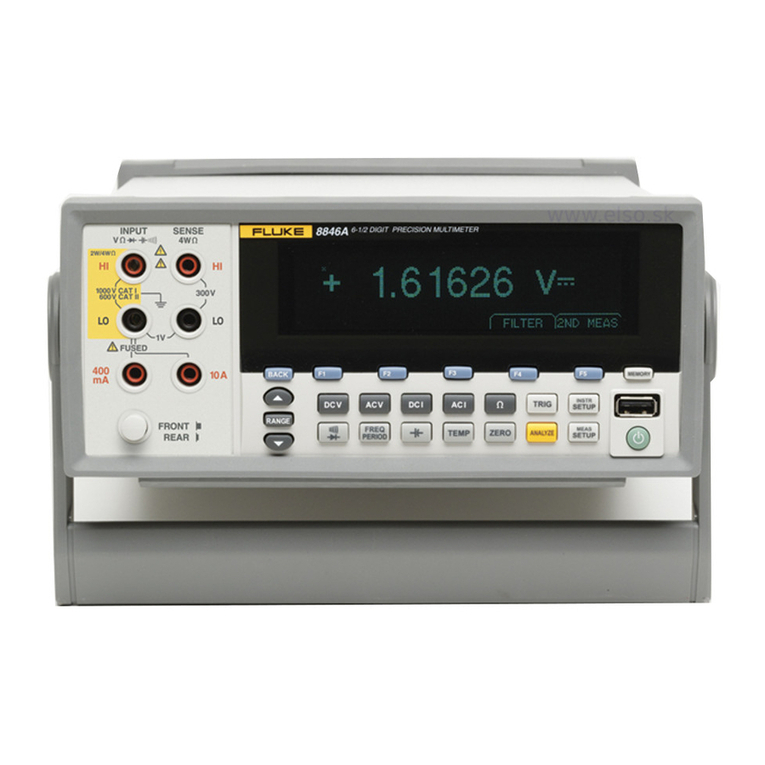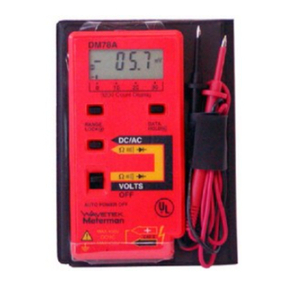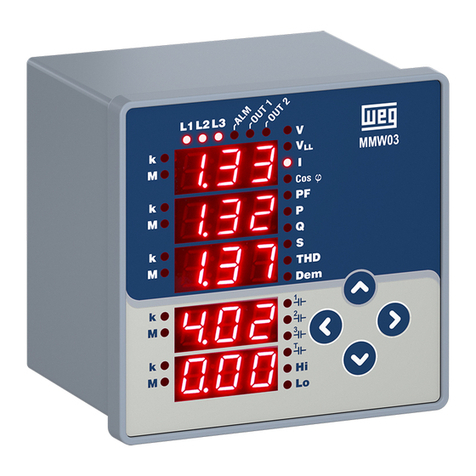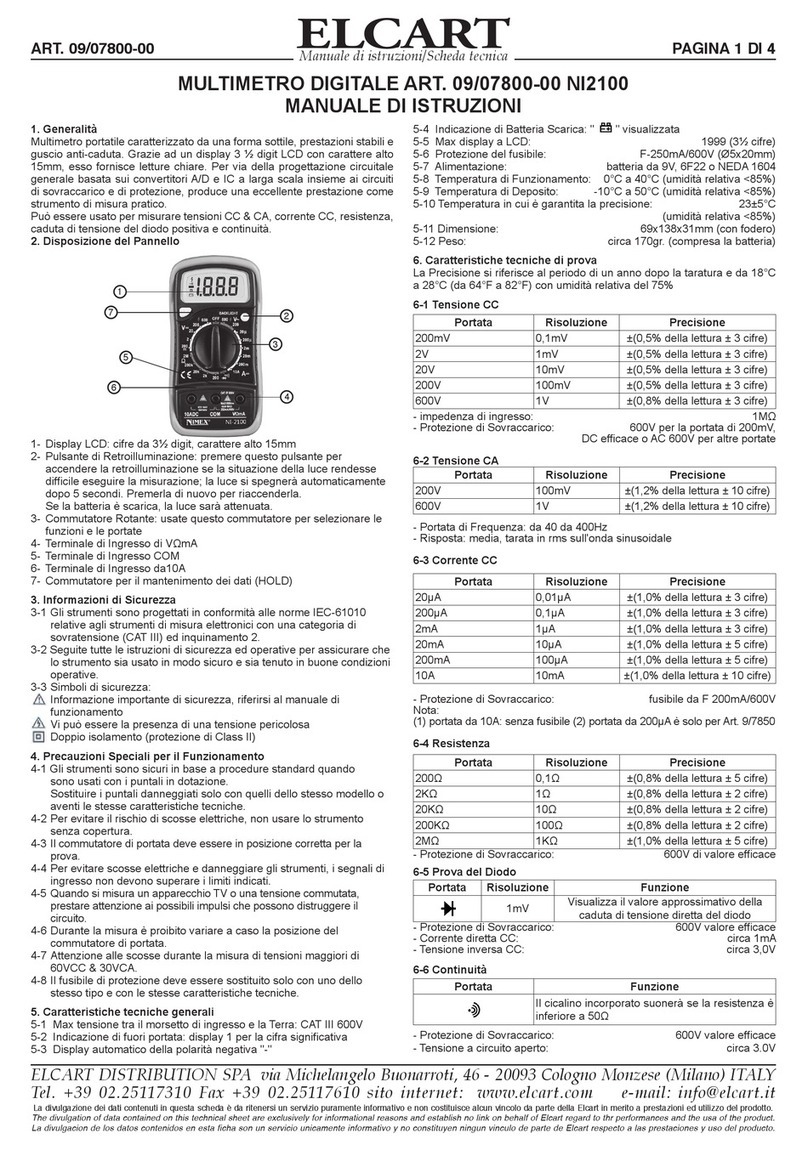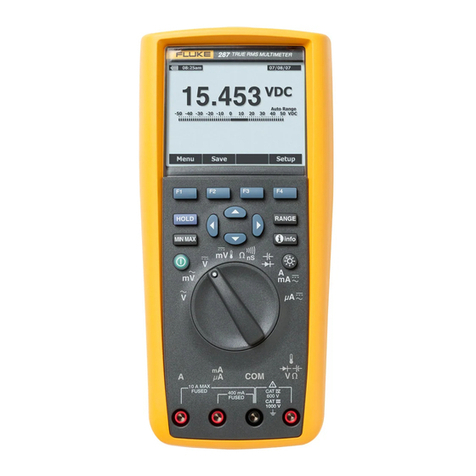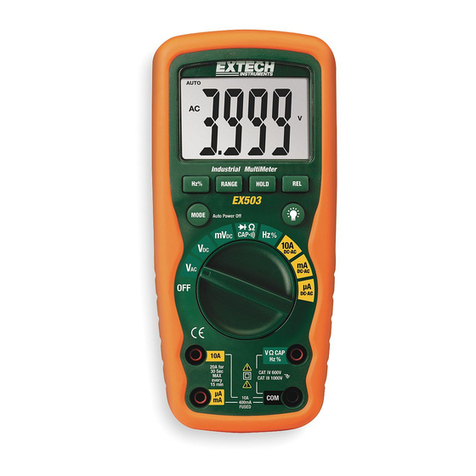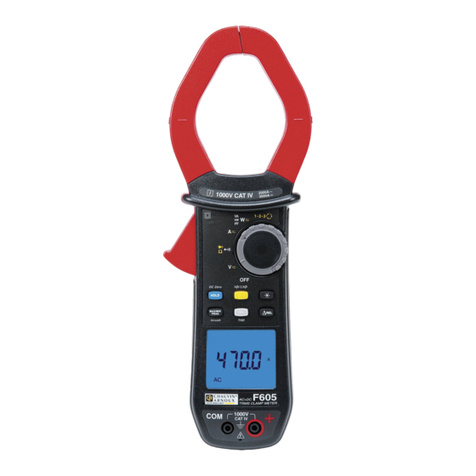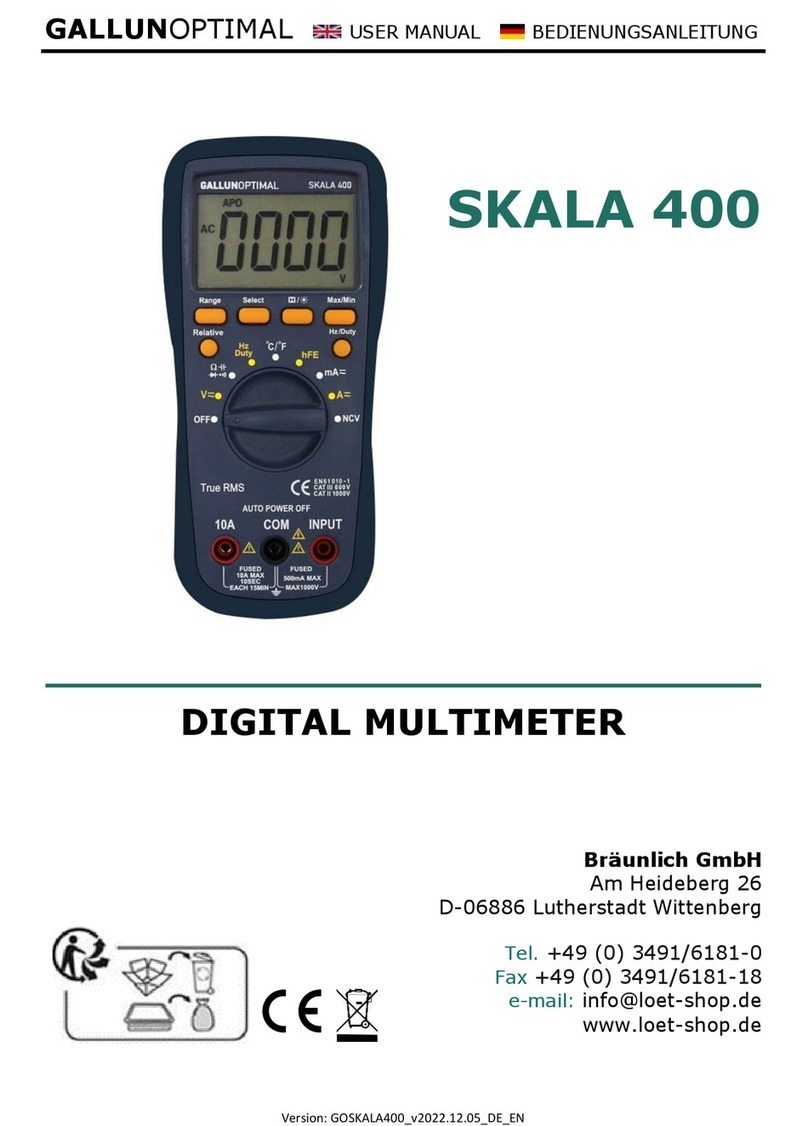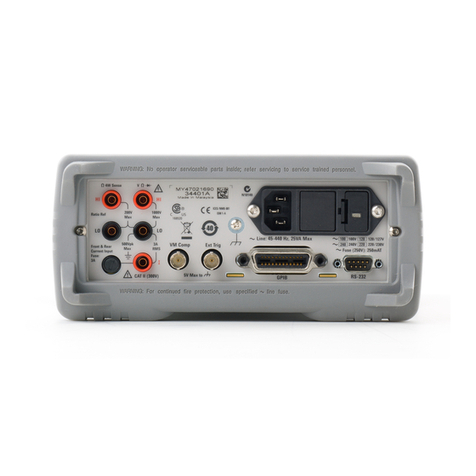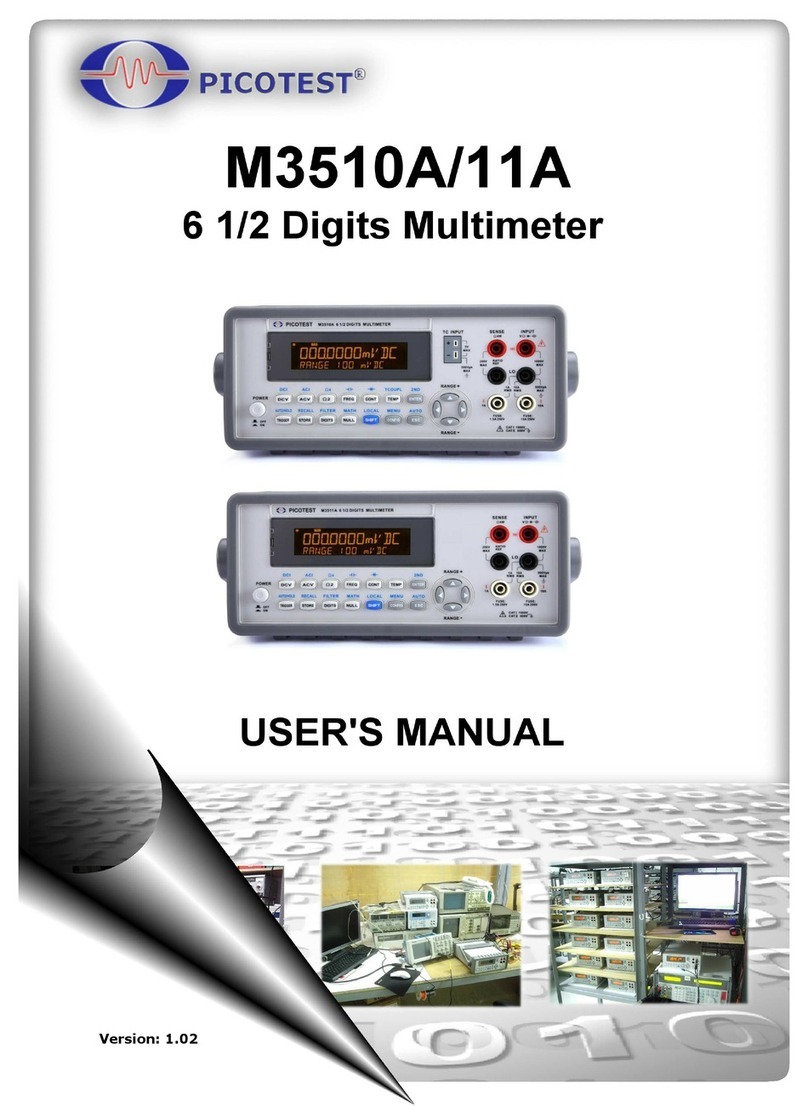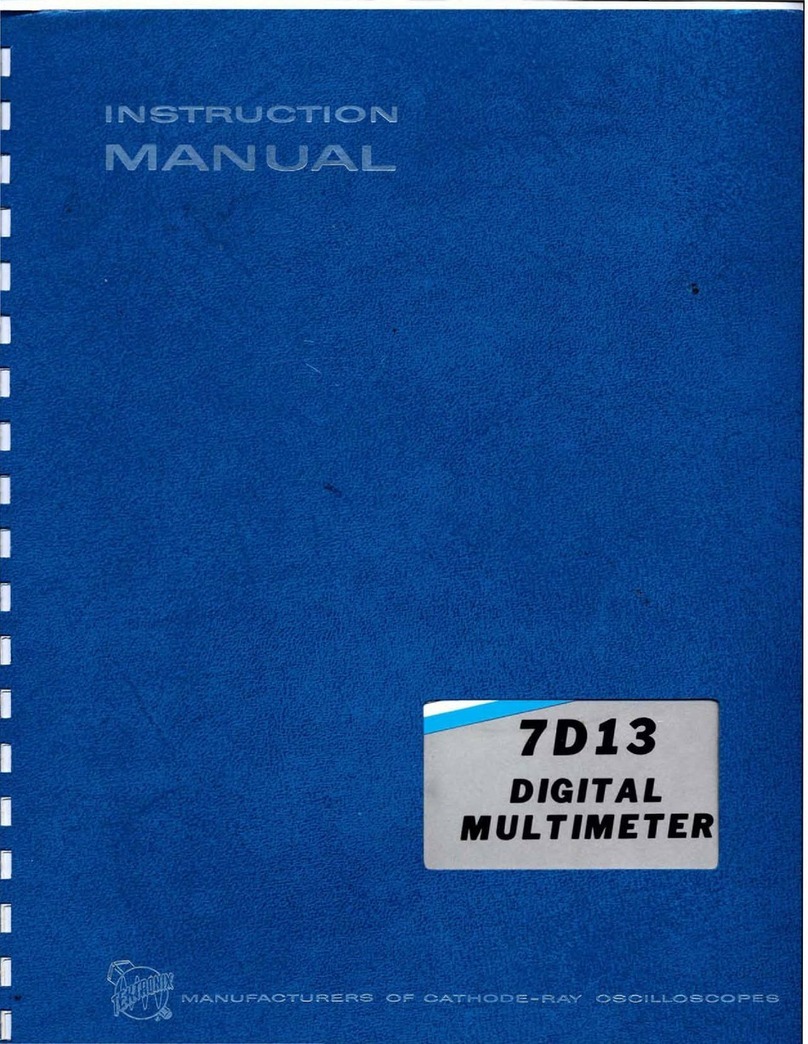Sourcetronic ST1941 User manual

OPERATION MANUAL
ST1941
41/2 Digit Multimeter
SOURCETRONIC GMBH
www.sourcetronic.com

2
Manual Printing History
The manual printing data and part number indicate its current edition. The printing date changes when a
new edition is printed. The manual part number changes when extensive technical changes are
incorporated.
October 2008……………………………First Edition
Notice
The information contained in this document is sub ect to change without notice.
Safety notice supplement
As described in the International Electrotechnical Commission (IEC) Standard IEC 664,
digital multimeter measuring circuits (e.g., Sourcetronic Models 1951, 1961, 1941, and
1942) are Installation Category II. All other instruments’ signal terminals are Installation
Category I and must not be connected to mains.
This equipment is POLLUTION DEGREE 2, INDOOR USE product.
Safety Precautions
Users of this product must be protected from electric shock at all times. The responsible
body must ensure that users are prevented access and/or insulated from every connection
point. In some cases, connections must be exposed to potential human contact. Product
users in these circumstances must be trained to protect themselves from the risk of electric
shock. If the circuit is capable of operating at or above 1000 volts, no conductive part of the
circuit may be exposed.

3
Before operating an instrument, make sure the line cord is connected to a properly
grounded power receptacle. Inspect the connecting cables, test leads, and jumpers for
possible wear, cracks, or breaks before each use.
For maximum safety, do not touch the product, test cables, or any other instruments while
power is applied to the circuit under test. ALWAYS remove power from the entire test
system and discharge any capacitors before: connecting or disconnecting cables or
jumpers, or making internal changes, such as installing or removing jumpers.
Do not touch any object that could provide a current path to the common side of the circuit
under test or power line (earth) ground. Always make measurements with dry hands while
standing on a dry, insulated surface capable of withstanding the voltage being measured.
The instrument and accessories must be used in accordance with its specifications and
operating instructions or the safety of the equipment may be impaired.
Do not exceed the maximum signal levels of the instruments and accessories, as defined in
the specifications and operating information, and as shown on the instrument or test fixture
panels.
When fuses are used in a product, replace with the same type and rating for continued
protection against fire hazard.
Chassis connections must only be used as shield connections for measuring circuits, NOT
as safety earth ground connections.
If you are using a test fixture, keep the lid closed while power is applied to the device under
test.

4
Contents
Chapter 1 General Information ............................................................................................................................. 7
1.1 Feature Overview......................................................................................................................................... 7
1.2 Operating Environment ............................................................................................................................... 7
1.3 Dimensions and Weight............................................................................................................................... 7
1.4 Safety symbols and Precautions .................................................................................................................. 8
1.5 Incoming Inspection .................................................................................................................................... 8
1.6 Warranty....................................................................................................................................................... 9
1.7 Limitation of Warranty ................................................................................................................................ 9
Chapter 2 ST1941 Overview............................................................................................................................... 10
2.1 Front Panel Summary................................................................................................................................ 10
2.2 Annunciators on Screen..............................................................................................................................11
2.3 Front Panel Menu Reference ..................................................................................................................... 12
2.4 Front Panel Menu Overview...................................................................................................................... 13
2.5 Rear Panel Summary ................................................................................................................................. 14
2.6 Power up.................................................................................................................................................... 15
2.6.1 Power Line Connection.............................................................................................................. 15
2.6.2 Input Terminals............................................................................................................................ 15
2.6.3 Power-up Sequence................................................................................................................... 16
2.6.4 High Energy Circuit Safety Precautions .................................................................................. 16
2.6.5 Power-on Defaults....................................................................................................................... 17
2.6.6 Warm-up time .............................................................................................................................. 17
2.7 Display....................................................................................................................................................... 17
Chapter 3 Basic Measurements ......................................................................................................................... 18
3.1 Preparation................................................................................................................................................. 18
3.2 Measuring Voltage..................................................................................................................................... 18
3.2.1 Connections................................................................................................................................. 18
3.3 Measuring Current..................................................................................................................................... 19
3.3.1 Connections................................................................................................................................. 19
3.3.2 Front Panel Fuse Replacement................................................................................................ 21
3.4 Measuring Resistance................................................................................................................................ 22
3.4.1 Connections................................................................................................................................. 22
3.4.2 Shielding....................................................................................................................................... 22
3.5 Measuring Frequency and Period.............................................................................................................. 23
3.5.1 Trigger Level and Measurement Errors................................................................................... 23
3.5.2 Gate Time..................................................................................................................................... 23
3.5.3 Connections................................................................................................................................. 23
3.6 Measuring Continuity................................................................................................................................ 24
3.6.1 Connections................................................................................................................................. 24
3.7 Testing Diode............................................................................................................................................. 25
3.7.1 Connections................................................................................................................................. 25
3.8 Measuring True RMS AC+DC .................................................................................................................. 26
3.8.1 Connections................................................................................................................................. 26

5
3.8.2 Using the 2
nd
parameter display ............................................................................................... 27
3.9 Math Functions.......................................................................................................................................... 27
3.9.1 Percent ......................................................................................................................................... 27
3.9.2 dB Calculation.............................................................................................................................. 28
3.9.3 dBm Calculation.......................................................................................................................... 29
Chapter 4 Measurement Options....................................................................................................................... 31
4.1 Measurement configuration....................................................................................................................... 31
4.1.1 Range ........................................................................................................................................... 31
4.1.2 Relative......................................................................................................................................... 32
4.1.3 Rate............................................................................................................................................... 32
4.2 Trigger Operations..................................................................................................................................... 33
4.2.1 Trigger procedure........................................................................................................................ 33
4.2.2 Reading Hold............................................................................................................................... 34
4.3 MAX / MIN............................................................................................................................................... 34
4.4 Limit Operations........................................................................................................................................ 35
4.4.1 Enabling limits.............................................................................................................................. 35
4.4.2 Setting Limit Values.................................................................................................................... 35
4.5 System Operations..................................................................................................................................... 36
4.5.1 Beeper Control ............................................................................................................................ 36
4.5.2 Baud rate...................................................................................................................................... 36
4.5.3 Selecting the Terminal Character.............................................................................................. 37
4.5.4 Key Sound.................................................................................................................................... 37
Chapter 5 Remote Operation.............................................................................................................................. 39
5.1 RS-232....................................................................................................................................................... 39
5.2 RS-232 Interface Operation....................................................................................................................... 39
5.2.1 RS-232 Connection .................................................................................................................... 39
5.2.2 Sending and receiving data....................................................................................................... 40
5.2.3 Selecting Baud Rate................................................................................................................... 41
5.2.4 Software Protocol........................................................................................................................ 41
5.3 Data Format............................................................................................................................................... 42
Chapter 6 SCPI Command Reference.............................................................................................................. 43
6.1 Command structure.................................................................................................................................... 43
6.2 Command Syntax....................................................................................................................................... 43
6.2.1 Commands and command parameters................................................................................... 43
6.2.2 Short-form Rules......................................................................................................................... 45
6.2.3 Basic Rules of Command Structure......................................................................................... 45
6.2.4 Multiple Command Rules........................................................................................................... 46
6.2.5 Command Path Rules................................................................................................................ 46
6.3 Command Reference ................................................................................................................................. 46
6.3.1 DISPlay subsystem..................................................................................................................... 46
6.3.2 FUNCtion subsystem.................................................................................................................. 48
6.3.3 VOLTage subsystem................................................................................................................... 49
6.3.4 CURRent subsystem.................................................................................................................. 53
6.3.5 RESIister subsystem.................................................................................................................. 57

6
6.3.6 FREQuency and PERiod subsystem....................................................................................... 60
6.3.7 HOLD subsystem........................................................................................................................ 62
6.3.8 TRIGger subsystem.................................................................................................................... 64
6.3.9 FETCH Subsystem..................................................................................................................... 64
6.3.10 Common Commands ............................................................................................................... 65
Chapter 7 Specifications...................................................................................................................................... 66
Chapter 8 Program Examples............................................................................................................................. 71

7
Chapter 1 General Information
Thanks very much for choosing and using our product. If you have any questions after reviewing this
manual, please contact your local representative or call directly to our application engineers for further
consultation.
1.1 Feature Overview
ST1941 is a 4½digital multimeter with high accuracy, stability and speed. The digital multimeter provides
a maximum measurement speed of 25 readings/sec. ST1941 has a 0.01% DC voltage basic accuracy,
0.03% basic resistance accuracy and other high performance. ST1941 has broad measurement ranges:
DC voltage from 10µV to 1000V
AC (RMS) voltage from 10µV to 750V, 1000V Peak
DC current from 100nA to 20A
AC (RMS) current from 100nA to 20A
Two -wire resistance from 10mΩto 20MΩ
Frequency from 5Hz to 1MHz
Some additional capabilities of Model ST1941:
Full range of functions: In addition to those listed above, The ST1941 functions include period,
dB, dBm, continuity, diode testing, max, min and percent.
Programming languages and remote control interfaces: The ST1941 provides the SCPI
programming language and the remote control interface port: RS-232C.
Closed-cover calibration: The multimeter can be calibrated either from the front panel or
through the remote control interface.
1.2 Operating Environment
Power supply: 110V/220V ±10%
Line frequency: 50Hz / 60Hz ±5%
Power consumption: <10VA
Operating temperature: 0℃to 40℃
Humidity: ≤90%RH
1.3 Dimensions and Weight
Dimensions(W×H×D):225mm
×
100mm
×
318mm
Net weight:Around 2.2Kg

8
1.4 Safety symbols and Precautions
The symbol on the instrument indicates that user should refer to the operating instructions located
in the manual before performing.
The symbol on the instrument shows that high voltage may be present on the terminal(s). Be
careful to avoid personal contact with these voltages.
The symbol on the instruments means earth grounding.
The WARNING heading used in the manual explains high voltage danger that might result in personal
injury or death. Always read the associated information very carefully before performing the indicated
procedure.
The CAUTION heading in the manual reminds user that hazards could damage the instruments if not
according to operating instructions. Such damage may invalidate the warranty.
1.5 Incoming Inspection
The ST1941 was carefully inspected mechanically and electrically before shipment. After unpacking all
items from the shipping carton, please check for any obvious signs of physical damage that may have
occurred during transportation. Report any damage to the shipping agent immediately. Save the original
packing carton for possible future reshipment. The following items are included with every Model
ST1941 order:
Model ST1941 4
1
/
2
Digital Multimeter
Test leads (Model ST26036)
Power cord
Two 500mA fuses
Two 1A fuses
Operation Manual
Quality and warranty certificate
Test report
Other optional accessories if ordered
Verify that you have received all the items above when you get multimeter. If anything is missing, please
contact our representative or our sales office.

9
1.6 Warranty
Sourcetronic warrants this product to be free from defects in material and workmanship for a period of 1
year from the date of shipment. During the warranty period, we will, at our option, either repair or replace
any product that proves to be defective.
1.7 Limitation of Warranty
This warranty does not apply to defects resulting from product modification without our express written
consent, or misuse of any product or part. This warranty also does not apply to fuses, software, or
problems arising from normal wear or failure to follow instructions.
THIS WARRANTY IS IN LIEU OF ALL OTHER WARRANTIES, EXPRESSED OR IMPLIED, INCLUDING ANY
IMPLIED WARRANTY OF MERCHANTABILITY OR FITNESS FOR A PARTICULAR USE. THE REMEDIES
PROVIDED HEREIN ARE BUYER’S SOLE AND EXCLUSIVE REMEDIES.
NEITHER SOURCETRONIC NOR ANY OF ITS EMPLOYEES SHALL BE LIABLE FOR ANY DIRECT,
INDIRECT, SPECIAL, INCIDENTAL OR CONSEQUENTIAL DAMAGES ARISING OUT OF THE USE OF ITS
INSTRUMENTS AND SOFTWARE EVEN IF SOURCETRONIC HAS BEEN ADVISED IN ADVANCE OF THE
POSSIBILITY OF SUCH DAMAGES. SUCH EXCLUDED DAMAGES SHALL INCLUDE, BUT ARE NOT
LIMITED TO: COSTS OF REMOVAL AND INSTALLATION, LOSSES SUSTAINED AS THE RESULT OF
INJURY TO ANY PERSON, OR DAMAGE TO PROPERTY.

10
Chapter 2 ST1941 Overview
2.1 Front Panel Summary
The front panel of the ST1941 is shown in Figure 2-1. This figure includes some important abbreviated
information that should be reviewed before operating the instrument.
!
C A T
Ⅰ(
1000V
)
C A T
Ⅱ(
300V
)
Ω
ΩΩ
Ω
COM
20A
T1AL 250V
ALL INPUT
1KV MAX
500mA
MAX
V
10 0 0V
M A X
DC I AC I
Period
dB dBm
%
Comp
Hold
Menu Local
2nd
DC V
DC VDC V
DC V AC V
AC VAC V
AC V
Ω
ΩΩ
Ω
Freq
FreqFreq
Freq
AC+DC
AC+DCAC+DC
AC+DC
Rel
RelRel
Rel
Rate
RateRate
Rate
Esc
EscEsc
Esc Shift
ShiftShift
Shift
Trig
TrigTrig
Trig
Auto
AutoAuto
Auto
m A
DC
AC
MED
FAST
SLOW
REL
HOLD
TRIG
MATH
AUTO
DC
AC
COMP
AUTO
MAX
MIN
SHIFT
RMT
IN
LO
HI
ERR
4 Digit Multimeter
TH1941
1
2
POWER
ON OFF
Figure 2-1 ST1941 Front Panel
1. Measurement Function keys (shifted and unshifted)
Select measurement function: DC voltage and current, AC voltage and current, resistance,
continuity, frequency, period, dB, dBm, AC+DC and diode test.
2. Math function keys
Select the math function: Rel, %, Max/Min, Comp and Hold.
3. 2
nd
Display and speed key
Changes reading rate: Fast, Medium and Slow.
→ turns on/ off the 2
nd
parameter display.
4. Menu operation keys
Shift
→Open/Close menu
Move through selections within menu level, command level or parameter level
Move through selections within menu level, command level or parameter level.
Move up a level.
Move down a level.
(ENTER) Save the change made on “parameter” level, and return to the “command” level.
Cancel the change made on “parameter” level, and return to the “command” level.
5. Range and Combination function selecting keys
Select a 2
nd
display parameter
Select a 2
nd
display parameter
Primary
Display
Secondary
Display
On /off
Switch
Current
Input fuse
Input terminals
5. Range
Selection
1. Function keys
2. Math function keys
4. Menu
Operation 3. 2
nd
Display
And speed keys
7. Shift/local
Keys
6. Hold/Trig
Keys
ST1941

11
Select a higher range and disable auto ranging.
Select a lower range and disable auto ranging.
Toggle between auto ranging and manual ranging.
6. Trig/Hold Key
Trig
Trigger a measurement from the front panel.
Shift
→
Trig
Hold a stable reading on the display when selected numbers of samples are
within the selected tolerance.
7. Shift/Local keys
Shift
Used to access shifted keys.
Shift
(LOCAL) Cancel RS232C remote control mode and back to the LOCAL mode.
2.2 Annunciators on Screen
DC
AC
MED
FAST
SLOW
REL
HOLD
TRIG
MATH
AUTO
DC
AC
COMP
AUTO
MAX
MIN
SHIFTRMT
IN
LO
HI
ERR
Figure 2-2 Display Annunciators
FAST Fast reading rate
MED Medium reading rate
SLOW Slow reading rate
TRIG Indicates external trigger (front panel, bus) selected.
HOLD Reading HOLD function is enabled
REL Relative reading displayed
MATH A math operation is enabled (%, dB, dBm).
(Speaker) Beeper on for continuity testing function
(Diode) Instrument is in diode testing function
DC DC operation is enabled
AC AC operation is enabled
COMP Limit testing function is enabled
HI/IN/LO Indicates the limit testing results
RMT Multimeter is in remote control mode
AUTO Auto ranging enabled
Max/Min MAX / MIN operation is enabled
ERR Hardware or remote control error detected
SHIFT Accessing shifted keys

12
2.3 Front Panel Menu Reference
A:
::
:MATH MENU
1: HI LIMIT →2: LO LIMIT →3: PERC REF →4: dB REF→5: dBm REF
1. HI LIMIT Set the high limit for limit testing.
2. LO LIMIT Set the low limit for limit testing.
3. PERC REF Set the reference value for PERCENT function
4. dB REF Set the dB reference voltage value.
5. dBm REF Set the dBm reference impedance value.
B:
::
:TRIGger MENU
1: TRIG MOD →2: HOLD WIN→3: HOLD CNT
1. TRIG MOD Select IMMediate, Manual or Bus trigger source mode.
2. HOLD WIN Set the reading hold sensitivity band.
3. HOLD CNT COUNT of readings for reading hold.
C:
::
:SYStem MENU
1: BEEP STA →2: BAUD RAT →3: TX TERM →4: KEY SONG
1. BEEP STA Enable or disable the beeper function
2. BAUD RAT Select the baud rate for RS232C operation.
3. TX TERM Set the terminal character for RS232 operation, which identifies the end of a
command string
4. KEY SONG Enable or disable the key sound when you press a key.

13
2.4 Front Panel Menu Overview
The menu is organized in a top-down tree structure with three levels (menus, commands and
parameters) as shown in Figure 2-3. You can use down ( ) or up ( ) to move menu tree from
one level to another. Each of the three levels has several horizontal choices which you can view by using
left ( ) or right ( ).
Figure 2-3 Menu Tree
To turn on the menu, press
Shift
→(Menu).
To turn off the menu, press
Shift
→ (Menu), or press any of the function or math keys on
the front panel.
To confirm a change on the “parameter” level, press (ENTER).
To cancel a change on the “parameter” level, press (Menu).
Note: If you press on the “menu” level, this is the top level of the menu and you can not
go any higher; similarly if you press on the “parameter” level, this is the bottom level of
the menu and you can not go any lower.
Menus
Commands
Parameters

14
2.5 Rear Panel Summary
The rear panel of ST1941 is shown in Figure 2-4. This section includes important information that should
be reviewed before operating the instrument.
1 2 3
贴标签
RS-232C
!
TO AVOID ELECTRIC SHOCK,
THE POWER CORD PROTECTIVE GROUNDING
CONDUCTOR MUST BE CONNECTED TO GROUND.
DISCONNECT POWER SUPPLY BEFORE
REPLACING FUSE.
WARNING
10VA Max
FUSE
T500mAL
T1AL
RATING
~
110V/
~
220V/
60Hz
50Hz
4
Figure 2-4 ST1941 Rear Panel
1. RS-232C Connector
Connector for RS-232 operation. Use a standard DB-9 cable.
2. Grounding
Chassis Grounding terminal
3. Power-Line Fuse-Holder Assembly
ST1941 can be configured for line voltage of 110/220V±10% AC at line frequency of 50/60Hz±5%.
Power-line fuse is used for instrument protection. (220V/500mA or 110V/1A)
Note: Please use the same-type fuse or contact your nearest Sourcetronic sales and service
office. To verify and replace the fuse, remove the power cable and pull out the fuse
holder.
4. Label
Serial number for this instrument

15
2.6 Power up
2.6.1 Power Line Connection
Follow the procedure below to connect the ST1941 to line power and turn on the instrument.
1. Check to make sure that the line voltage is in the range of 198V to 242V (or 110V±10%) and line
frequency is in the range of 47.5 to 52.5Hz (or 60Hz±5%) before connecting the power cord.
CAUTION: Operating the instrument on an incorrect voltage may cause damage to the
instrument, possibly voiding the warranty.
2. Before plugging in the power cord, make sure that the front panel power switch is in the off position.
3. Connect the female end of the supplied power cord to theAC receptacle on the rear panel. Connect
the other end of the power cord to a grounded AC outlet.
WARNING: The power cord supplied with the Model ST1941 contains a separate ground wire for
use with grounded outlets. When proper connections are made, instrument chassis
is connected to power line ground through the ground wire in the power cord. Failure
to use a grounded outlet may result in personal injury or death due to electric shock.
4. Turn on the instrument by pressing the front panel power switch and get ready for measuring.
2.6.2 Input Terminals
The input terminals are shown in Figure 2-5. The multimeter is protected against overloads up to the
limits as shown in table 2-1. Exceeding these limits may result in a hazard to both the multimeter and
operator.
!
C A T
Ⅰ(
1000V
)
C A T
Ⅱ(
300 V
)
Ω
ΩΩ
Ω
COM
20A
T1AL 250V
ALL INPUT
1KV MAX
500mA
MAX
V
1000V
M A X
m A
Figure 2-5 Input terminals
Input-High terminal for Volts, ohms, HZ, period, diode and
continuity measurements
2mA~200mA range DC/AC current input terminal for
DC/AC current measurements
Common terminals
2A/10A range current input terminal for DC/AC current
measurement
2mA~ 200mArange fuse (T1AL/250V)

16
Table 2-1 Input protection Limits
Function Input Terminals Maximum Allowable Input
DCV to COM 1010V DC
ACV,HZ to COM 757.5V AC RMS,1000V Peak
mA, HZ 500mA to COM 200mADC orAC RMS
20A,HZ 20A to COM 20A DC or AC RMS
Ωto COM 500V DC orAC RMS
,
to COM 500V DC orAC RMS
All functions Any terminals to earth 1000V DC or 1000V peakAC
2.6.3 Power-up Sequence
On power-up, Model ST1941 performs self-tests on its EPROM and RAM and lights all segments and
annunciators for about 1 second. If a failure is detected, the instrument momentarily displays an error
message and the ERR annunciator turns on.
If the instrument passes self-tests, the firmware revision will be displayed.
2.6.4 High Energy Circuit Safety Precautions
To optimize safety when measuring voltage in high energy distribution circuits, read and use the
directions in the following warning.
When making measurements in high energy circuits, use test leads and accessories that meet the
following requirements:
Test leads and accessories must be fully insulated.
Only use test leads that can be connected to the circuit (e.g., alligator clips, spade lugs, etc.) for
hands-off measurements.
Do not use test leads or accessories that decrease voltage spacing. This diminishes arc
protection and creates a hazardous condition.
Use the following sequence when measuring high energy circuits:
1. De-energize the circuit using the regular installed connect-disconnect device, such as a circuit
breaker, main switch, etc.
2. Attach the test leads to the circuit under test. Use appropriate safety rated test leads for this
application.
3. Set the multimeter to the proper measurement function and range.
4. Energize the circuit using the installed connect-disconnect device and make measurements
without disconnecting the multimeter.
5. De-energize the circuit using the installed connect-disconnect device.
6. Disconnect the test leads from the circuit under test.
WARNING: The maximum common-mode voltage (voltage between COM and the chassis
ground) is 500V peak. Exceeding this value may cause a breakdown in insulation,
creating a shock hazard.

17
2.6.5 Power-on Defaults
Model ST1941 uses the factory default settings for the power-on settings.
Since the basic measurement procedures in this manual assume the factory defaults, reset the
instrument to the factory settings when following step-by-step procedures. Table 2-2 lists the factory
default settings. Table 2-2 Factory Default Settings
Setting Factory Default
Function
Range
Rate
Remote/Local
Trigger Mode
Relative Mode
Compare Mode
HI Limit
Lo Limit
Percent Mode
Reference
Max/Min Mode
Reading Hold
Secondary Display Mode
Cal Mode
DCV
AUTO
Medium
Local
Immediate
OFF
OFF
+1
-1
OFF
+1
OFF
OFF
OFF
OFF
2.6.6 Warm-up time
Model ST1941 is ready for use as soon as the power-up sequence has completed. However, to achieve
rated accuracy and stability, allow the instrument to warm up for half an hour. If the instrument has been
subjected to extreme temperatures, allow additional time for internal temperatures to stabilize.
2.7 Display
The display of Model ST1941 is primarily used to display readings, along with the units and type of
measurement. Annunciators located on the left, right and bottom indicate various states of operation.
See section 2.2 for a complete listing of annunciators.

18
Chapter 3 Basic Measurements
3.1 Preparation
One of the first things you would like to do with your multimeter is to become acquainted with its front
panel. We have provided some exercises in foregoing chapters about preparations for use and
operations of front panel.
The front panel has six rows of keys to select various functions and operations. Most keys have a shifted
function printed in blue above the key. To perform a shifted function, press
Shift
(the Shift annunciator
will turn on). Then, press the key that has the desired label above it. For example, to select the AC
current function, press
Shift
then press
ACV
(ACI).
If you accidentally press
Shift
, just press it again to turn off the Shift annunciator.
3.2 Measuring Voltage
Voltage ranges: 200 mV, 2 V, 20 V, 200 V, 1000 V (750 VAC)
Maximum resolution: 10µV (on 200mV range)
AC technique: true RMS, ac-coupled, 1000V Peak AC
3.2.1 Connections
Assuming Model ST1941 is under factory default conditions, the basic procedure is as follows:
1. Connect test leads to and COM terminals.
2. Select DC or AC voltage measurement by pressing
DCV
or
ACV
.
3. Press toggles auto ranging. Notice that the AUTO annunciator is displayed with auto ranging.
If you want manual ranging, use the RANGE and keys to select a measurement range
consistent with expected voltage.
4. Connect test leads to the sources as shown in Figure 3-1.
CAUTION: Do not apply more than 1000V peak to the input or instrument damages may occur.
5. If the “OVL.D” message is displayed, press the up key to select a higher range until a normal
reading is displayed (or press key for auto ranging). Use the lowest possible range for the
best resolution.
6. press + to turn on the secondary display , Use or key to move across to
select the combination functions
7. Take readings from the display.

19
!
C A T
Ⅰ(
1000V
)
C A T
Ⅱ(
300V
)
Ω
ΩΩ
Ω
COM
20A
T1AL 250V
ALL INPUT
1KV MAX
500mA
MAX
V
1000V
M A X
DC I AC I
Period
dB dBm
%
Comp
Hold
Menu Local
2nd
DC V
DC VDC V
DC V AC V
AC VAC V
AC V
Ω
ΩΩ
Ω
Freq
FreqFreq
Freq
AC+DC
AC+DCAC+DC
AC+DC
Rel
RelRel
Rel
Rate
RateRate
Rate
Esc
EscEsc
Esc Shift
ShiftShift
Shift
Trig
TrigTrig
Trig
Auto
AutoAuto
Auto
m A
4 Digit Multimeter
TH1941
12
POWER
ON OFF
DC VOLTAGE SOURCE
- +
MED
AUTO
Input Resistance = 10MΩ
CAUTION:Maximum Input=1010V peak
!
C A T
Ⅰ(
1000V
)
C A T
Ⅱ(
30 0V
)
Ω
ΩΩ
Ω
COM
20A
T1AL 250V
ALL INPUT
1KV MAX
500mA
MAX
V
1000V
M A X
DC I AC I
Period
dB dBm
%
Comp
Hold
Menu Local
2nd
DC V
DC VDC V
DC V AC V
AC VAC V
AC V
Ω
ΩΩ
Ω
Freq
FreqFreq
Freq
AC+DC
AC+DCAC+DC
AC+DC
Rel
RelRel
Rel
Rate
RateRate
Rate
Esc
EscEsc
Esc Shift
ShiftShift
Shift
Trig
TrigTrig
Trig
Auto
AutoAuto
Auto
m A
4 Digit Multimeter
TH1941
1
2
POWER
ON OFF
SOURCEAC VOLTAGE
MED
AUTO
Input Impedance = 1.1MΩand 100pF
CAUTION: Maximum Input = 750V RMS or 1000V peak, 3×
××
×10
7
V-Hz
Figure 3-1 DC and AC Voltage Measurement Connections
3.3 Measuring Current
Model ST1941 current measurement range: 2mA, 20mA, 200mA (DC only), 2A, 20A
Maximum resolution: 100nA (on 2mA range)
3.3.1 Connections
Assuming Model ST1941 is under factory default conditions, the basic procedure is as follows:
1. Connect test leads between 500mA terminal and COM or between 20A terminal and COM.
2. Select DCI or ACI measurement function by pressing
Shift
→
DCV
or
Shift
→
ACV
3. Press toggles auto ranging. Notice the AUTO annunciator is displayed with auto ranging. If
you want manual ranging, use the RANGE and keys to select a measurement range
consistent with expected current.
4. Connect test leads to the source as shown in Figure 3-2:
ST1941
ST1941

20
CAUTION: Do not apply more than 1A, 250V to the 500mA input terminal or the fuse will be
open-circuit.
5. If the “OVL.D” message is displayed, press up key to select a higher range until a normal
reading is displayed (or press key for auto ranging). Use the lowest possible range for the
best resolution.
6. press + to turn on the 2nd parameter display , Use or key to move across
2
nd
display parameters
7. Take readings from the display.
!
C A T
Ⅰ(
10 0 0V
)
C A T
Ⅱ(
30 0 V
)
Ω
ΩΩ
Ω
COM
20A
T1AL 250V
ALL INPUT
1KV MAX
500mA
MAX
V
1000V
M A X
DC I AC I
Period
dB dBm
%
Comp
Hold
Menu Local
2nd
DC V
DC VDC V
DC V AC V
AC VAC V
AC V
Ω
ΩΩ
Ω
Freq
FreqFreq
Freq
AC+DC
AC+DCAC+DC
AC+DC
Rel
RelRel
Rel
Rate
RateRate
Rate
Esc
EscEsc
Esc Shift
ShiftShift
Shift
Trig
TrigTrig
Trig
Auto
AutoAuto
Auto
m A
4 Digit Multimeter
TH1941
1
2
POWER
ON OFF
DC SOURCE
- +
CURRENT
MED
AUTO
DC Current measurement on Range: 2mA, 20mA, 200mA
!
C A T
Ⅰ(
10 0 0V
)
C A T
Ⅱ(
30 0 V
)
Ω
ΩΩ
Ω
COM
20A
T1AL 250V ALL INPUT
1KV MAX
500mA
MAX
V
10 00 V
M A X
DC I AC I
Period
dB dBm
%
Comp
Hold
Menu Local
2nd
DC V
DC VDC V
DC V AC V
AC VAC V
AC V
Ω
ΩΩ
Ω
Freq
FreqFreq
Freq
AC+DC
AC+DCAC+DC
AC+DC
Rel
RelRel
Rel
Rate
RateRate
Rate
Esc
EscEsc
Esc Shift
ShiftShift
Shift
Trig
TrigTrig
Trig
Auto
AutoAuto
Auto
m A
4 Digit Multimeter
TH1941
1
2
POWER
ON OFF
AC SOURCECURRENT
MED AUTO
AC Current measurement on Range: 2mA, 20mA, 200mA
ST1941
ST1941
This manual suits for next models
1
Table of contents
Other Sourcetronic Multimeter manuals
